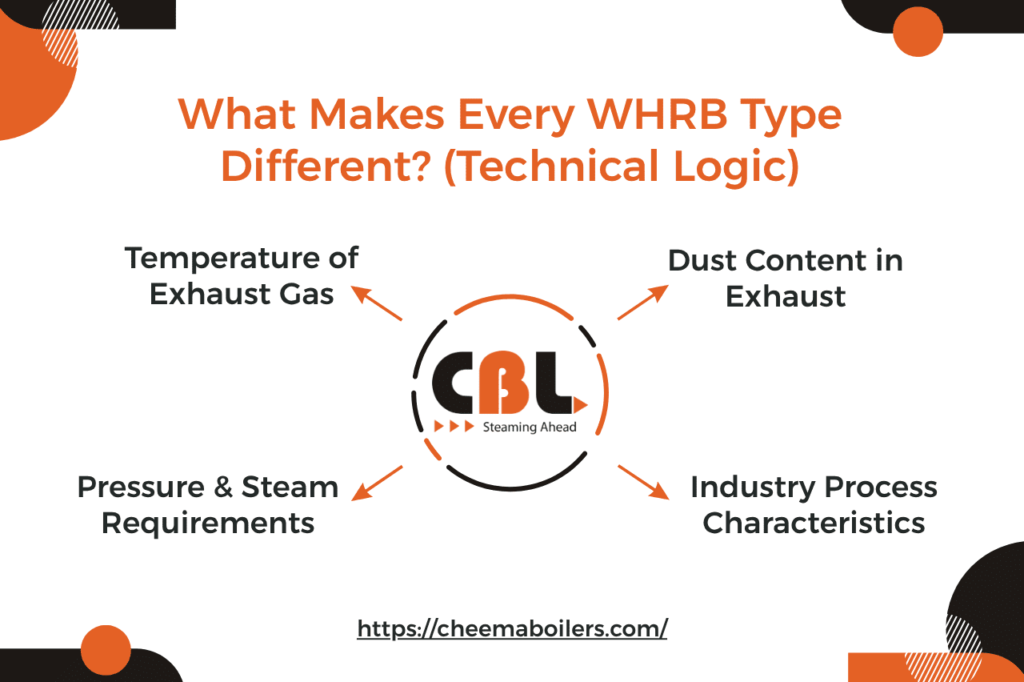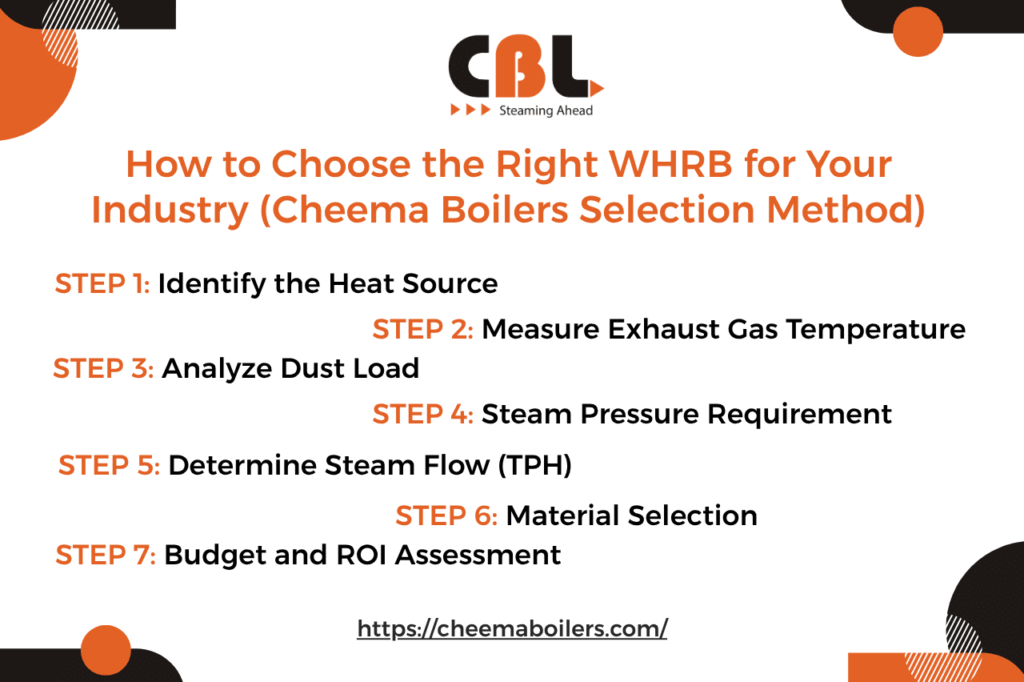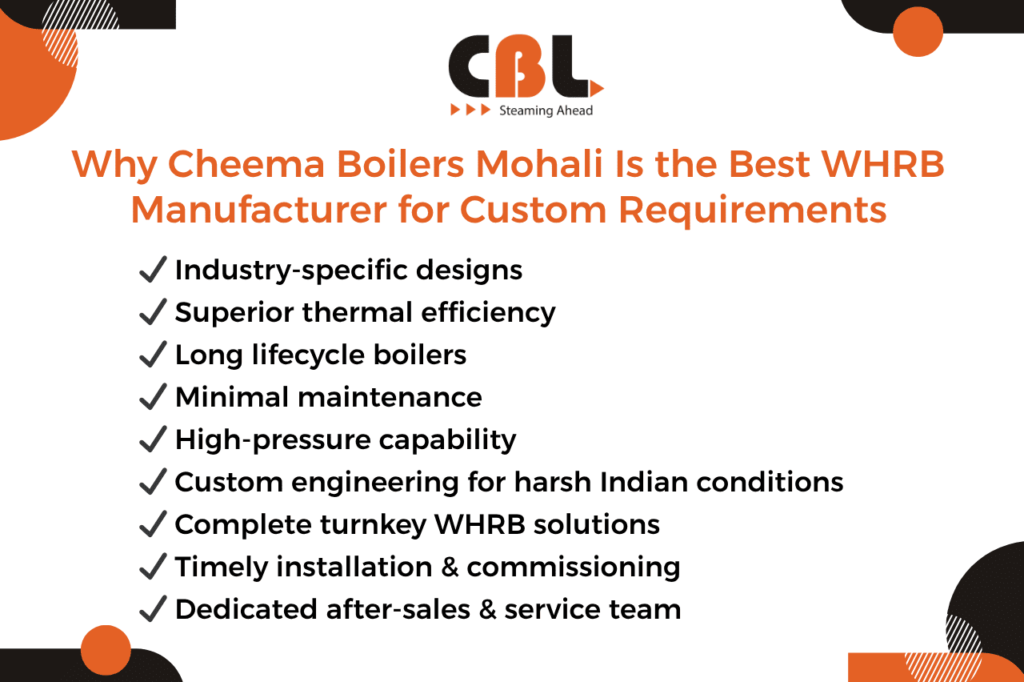Energy efficiency is no longer optional—it is the backbone of industrial competitiveness in India. As fuel prices continue to rise and sustainability requirements become stricter, industries across India are shifting toward Waste Heat Recovery Boilers (WHRBs) to reduce energy cost, increase process efficiency, and minimize carbon emissions.
But there’s a major challenge:
Every industry generates different types of waste heat—at different temperatures, dust levels, pressures, and chemical compositions.
This means:
One WHRB system can never fit every plant
Industries require custom-designed WHR boilers
Selecting the wrong type leads to poor efficiency, corrosion, and frequent maintenance
Selecting the right WHRB can save energy worth crores of rupees every year
That is why Cheema Boilers Mohali, one of the leading waste heat recovery boiler manufacturers in India, provides multiple WHRB designs tailored to each industry’s heat source and production requirements.
What Makes Every WHRB Type Different? (Technical Logic)

Before understanding WHRB types, it is crucial to know what makes them different.
Four factors determine the WHRB design:
1️⃣ Temperature of Exhaust Gas
Low-temperature heat (< 250°C)
Medium-temperature heat (250–600°C)
High-temperature heat (600–1,000°C)
2️⃣ Dust Content in Exhaust
Clean gas
Light dust load
Medium dust load
High dust load (cement, steel, sponge iron)
3️⃣ Pressure & Steam Requirements
Low-pressure industrial steam
Medium-pressure plant operations
High-pressure power generation steam
4️⃣ Industry Process Characteristics
Continuous or batch
Stable or fluctuating temperature
Corrosive gas composition
Cheema Boilers designs WHRB solutions based on these exact conditions.
Major Types of Waste Heat Recovery Boilers
Below are the industry-standard WHRB categories used across India, manufactured and supplied by Cheema Boilers Mohali.
TYPE 1: Water Tube Waste Heat Recovery Boiler
✔ Ideal For:
Cement plants
Steel & sponge iron plants
Gas turbine HRSG
Petrochemical plants
Power generation
✔ Description
In a water tube WHRB, water circulates through tubes while hot waste gases pass over them. This allows:
High heat absorption
High pressure handling
Fast steam generation
Long operational life
✔ Advantages
Can handle extremely high temperatures
Suitable for dusty and corrosive gases
Generates high-pressure steam (up to 100 bar)
Ideal for WHRB power plants
Low maintenance
✔ Applications
Rotary kiln exhaust
EAF furnace exhaust
Gas turbine exhaust
Coke oven gases
Refinery heater exhaust
✔ Why this type?
Large Indian plants prefer water tube WHRB because of efficiency, safety, and power generation capacity.
TYPE 2: Fire Tube Waste Heat Recovery Boiler
✔ Ideal For:
Small to medium industries
Chemical plants
Food processing
Textile units
Pharma units
✔ Description
Hot gases flow through tubes while water surrounds them.
✔ Advantages
Compact
Low cost
Easy to maintain
Suitable for low-to-medium temperature waste heat
Quick installation
✔ Limitations
Cannot handle high dust
Not suitable for very high pressures
Lower efficiency than water tube WHRB in large plants
TYPE 3: Horizontal WHRB
✔ Ideal For:
Chemical plants
Petrochemical units
Fertilizer industries
Refineries
✔ Description
Gas flows horizontally through banks of tubes. Helps increase residence time and heat absorption.
✔ Advantages
Excellent thermal efficiency
Easy cleaning of dust
Ideal for medium dust load
Long heat transfer path
TYPE 4: Vertical WHRB
✔ Ideal For:
Cement plants
Steel & DRI kilns
Space-restricted plants
✔ Description
Gas flows vertically downward through tube banks.
✔ Advantages
Reduced footprint
Better handling of heavy dust
Natural dust separation
Minimal erosion
✔ Why industries choose vertical WHRB?
Because dust naturally settles downward, leading to less tube erosion and longer life.
TYPE 5: Heat Recovery Steam Generator (HRSG)
✔ Ideal For:
Gas turbine power plants
Co-generation plants
Combined-cycle plants
Independent power producers
✔ Description
This WHRB converts gas turbine exhaust (500–650°C) into high-pressure steam for power generation.
✔ Advantages
High efficiency
Multi-pressure level steam
Large power output
Very stable operation
✔ Why choose HRSG?
If your plant has a gas turbine, HRSG is mandatory for achieving power generation economy.
TYPE 6: Hybrid Waste Heat Recovery Boiler
✔ Ideal For:
Industries with fluctuating temperature or irregular waste heat availability:
Chemical reactors
Batch furnaces
Glass melting
Petrochemical heaters
Small steel mills
✔ Description
A hybrid WHRB uses:
Waste heat plus
Auxiliary fuel firing
✔ Advantages
Constant steam supply
Zero production interruptions
High reliability
Flexible fuel options
✔ Why is it popular?
Many Indian plants face process instability; hybrid WHRB ensures uninterrupted steam.
TYPE 7: Super-Critical WHRB
✔ Ideal For:
Large refineries
Fertilizer plants
Power producers
Lignite-based plants
✔ Description
A very advanced WHRB that generates supercritical steam > 221 bar.
✔ Advantages
Highest efficiency
Suitable for mega energy-intensive systems
Used in high-end industries
✔ Note
One of the most advanced technologies used in India—Cheema Boilers provides custom design services for this category.
TYPE 8: Dust & Slag Handling WHRB (Specialized)
✔ Ideal For:
Cement
Steel
Sponge iron
Non-ferrous metals
✔ Description
Designed with advanced dust separation, slag arrestors, and erosion resistance.
✔ Advantages
Handles extremely dirty gases
Very long lifespan
Reduced downtime
Safe operations
How to Choose the Right WHRB for Your Industry (Cheema Boilers Selection Method)

Cheema Boilers Mohali uses a 7-Step WHRB Selection Framework:
STEP 1: Identify the Heat Source
Kiln
Furnace
Gas turbine
Engine
Reformer
Dryer
Chemical exothermic process
STEP 2: Measure Exhaust Gas Temperature
<250°C → Economizer / Low-temp WHRB
250–600°C → Medium WHRB
600–1000°C → High WHRB
1000°C → Special refractory-lined WHRB
STEP 3: Analyze Dust Load
Cement & DRI kilns → High dust WHRB
Engines & turbines → Clean gas HRSG
Refineries → Medium dust
STEP 4: Steam Pressure Requirement
10–20 bar → Industrial steam
30–45 bar → Power + steam
60–100 bar → Power generation
100 bar → Super-critical
STEP 5: Determine Steam Flow (TPH)
Cheema Boilers calculates:
Heat available
Efficiency
Gas velocity
Fouling factor
Boiler geometry
To determine TPH output.
STEP 6: Material Selection
Carbon steel
Alloy steel
Inconel
Refractory lining
Erosion-resistant tubes
STEP 7: Budget and ROI Assessment
WHRB selection depends on:
Operational cost savings
Investment budget
Expected ROI
Space availability
Cheema Boilers provides plant owners with a detailed cost-benefit analysis.
Industry-Wise WHRB Recommendation (Which Type You Need)
With 30+ years of experience, Cheema Boilers has created the following WHRB selection guide:
A. Cement Plants
Best WHRB Type:
Vertical water tube WHRB
AQC WHRB
PH WHRB
Why?
Handles heavy dust
High temperature
Robust tubes
Long life
B. Steel & Sponge Iron Plants
Best WHRB Type:
Waste gas boiler (kiln-based)
Vertical high-dust WHRB
Water tube WHRB
Why?
Dust, char, ash—needs rugged design
High-temperature (700–950°C)
C. Refineries & Petrochemicals
Best WHRB Type:
Horizontal WHRB
Hybrid WHRB
HRSG (for turbines)
Why?
Moderate dust
High temperature
Stable process
D. Gas Turbine & Engine Power Plants
Best WHRB Type:
HRSG
Why?
Extremely clean gas
High flow
Perfect for power generation
E. Chemical & Fertilizer Industries
Best WHRB Type:
Horizontal WHRB
Hybrid WHRB
Why?
Fluctuating processes
Medium temperature
F. Glass, Aluminium, Copper & Non-Ferrous Industries
Best WHRB Type:
Vertical WHRB
Fire tube WHRB (small units)
G. Textile, Paper & Food Processing
Best WHRB Type:
Fire tube WHRB
Economizer-type WHRB
H. Pharma & Small Chemical Units
Best WHRB Type:
Low-temperature WHRB
Small fire tube WHRB
Why Cheema Boilers Mohali Is the Best WHRB Manufacturer for Custom Requirements

Cheema Boilers Limited (CBL) is recognized as one of the top industrial boiler manufacturers in Punjab for a reason:
✔ Industry-specific designs
✔ Superior thermal efficiency
✔ Long lifecycle boilers
✔ Minimal maintenance
✔ High-pressure capability
✔ Custom engineering for harsh Indian conditions
✔ Complete turnkey WHRB solutions
✔ Timely installation & commissioning
✔ Dedicated after-sales & service team
With hundreds of installations across India, Cheema Boilers is trusted by major brands in:
Cement
Steel
Power
Chemical
Fertilizer
Food
Non-ferrous metals
Mistakes Industries Make While Choosing a WHRB (Avoid These)
❌ Choosing low-cost suppliers
Leads to corrosion, leakage, tube erosion.
❌ Not measuring dust load
Poor design = constant cleaning issues.
❌ Ignoring thermal mass flow
Results in low steam generation.
❌ Selecting wrong WHRB type
Can lose 30–50% heat recovery potential.
❌ Not planning WHRB with future expansion in mind
Industries often grow—WHRB must support that growth.
Cheema Boilers Mohali helps plants avoid all these mistakes with expert feasibility studies.
Conclusion
Every industry generates heat—but only the smartest industries recover it.
Choosing the right WHRB type is one of the most important decisions for an industrial plant in India. With rising fuel prices and competitive pressures, industries cannot afford to waste thermal energy that they already produce.
From cement kilns to steel furnaces, from turbines to chemical reactors—there is a specialized WHRB type for every process.
And the best part?
With a properly engineered WHRB from Cheema Boilers Mohali, industries save:
Fuel cost
Electricity cost
Maintenance cost
Cooling cost
Environmental penalties
while increasing:
Production efficiency
Plant reliability
Overall profitability
If your industry is planning to install a WHRB, Cheema Boilers offers the most accurate waste heat recovery system design, highest efficiency, and best-in-class engineering in India.

